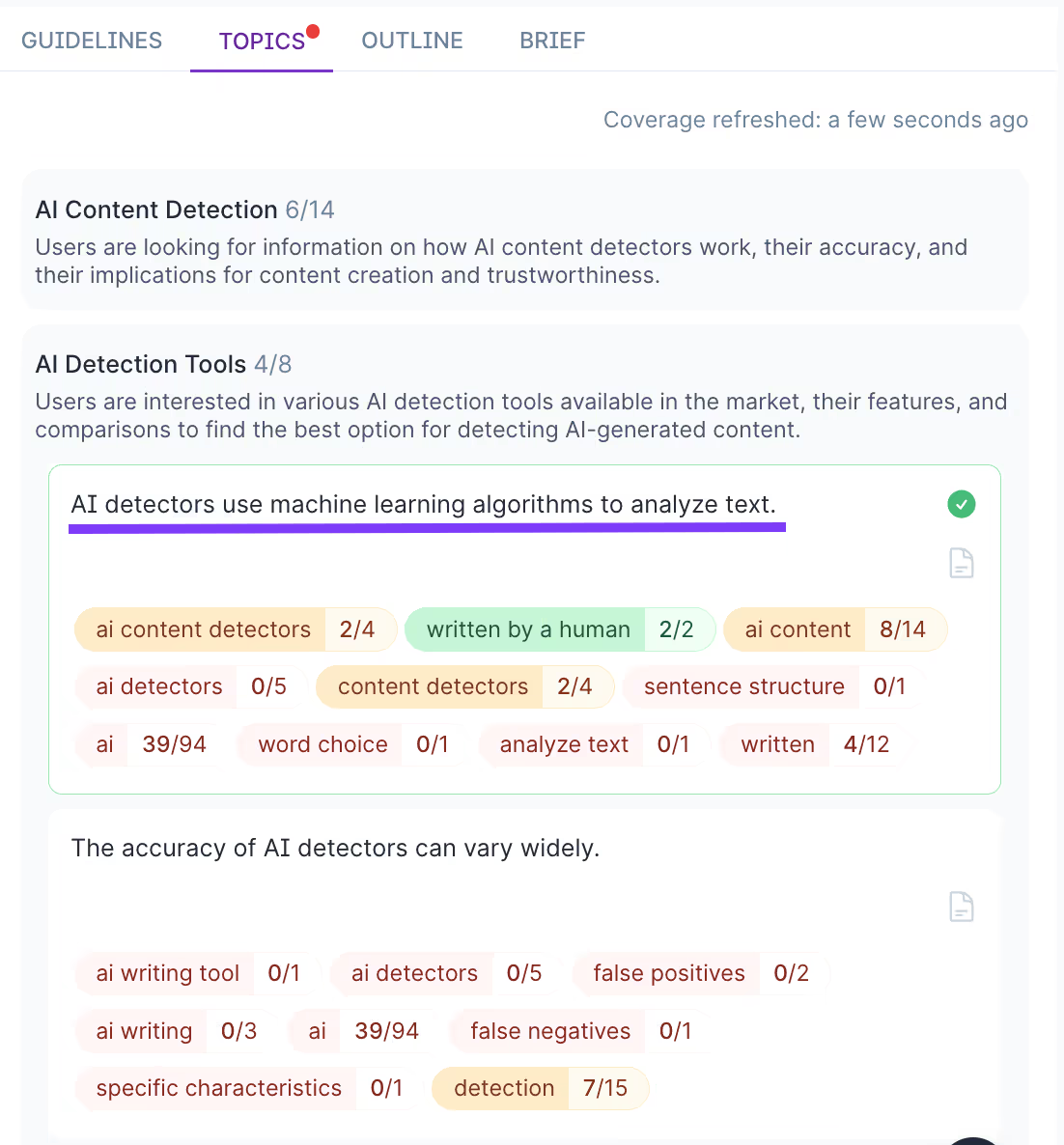I analyzed the top 100 Surfer blog posts and found that, overall, they are more comprehensive than the average content on SERPs.
Comprehensive content ranks better. Not really a shocker.
So, I dug a bit deeper to find out:
- How can we measure comprehensive content?
- Does comprehensive content correlate with rankings?
- How can you replicate such results?
.avif)
Stick around, and I’ll answer these questions for you.
Study methodology
To understand the relationship between content depth and SEO performance, I analyzed Surfer’s top 100 performing articles.
Our data science team started by evaluating how well our articles cover a topic. This means how many “facts” they include.
The more relevant “facts” an article includes, the more comprehensive it is.
Facts are pieces of information that are objectively true and provide more information on the subject.
For instance, “AI detectors use machine learning algorithms to analyze text” is a fact.

We identified these "facts" by analyzing the top 10 articles ranking for the target keyword.
We then calculated our "facts coverage" relative to these articles.
Next, we ranked our articles from highest to lowest "fact" coverage and compared this ranking to the order of SERP results.
To evaluate how closely the two rankings aligned, we used Spearman's rank correlation, a statistical method that measures the strength and direction of relationships between ranked variables.
Spearman's focuses on the consistency of rank order rather than numerical values, making it ideal for comparing rankings.
We repeated this analysis on a random sample of 100 articles, and the results were consistent.
How comprehensive content affects rankings
We found a correlation of 0.17 between “comprehensiveness” and rankings.
Let’s put these numbers into perspective. Keep in mind that the correlation between Surfer’s content score and rankings is 0.27.
While these numbers may appear small, they’re actually quite meaningful when you consider the bigger picture of SEO, which also includes factors like backlinks and user signals. From the one-third "slice of the SEO cake" reserved for content, these correlations account for a substantial portion—equivalent to almost one-fifth and one-third of the total SEO cake.
— Michał Suski, Head of Innovation & Co-founder @ Surfer
Simply put, articles that cover a topic comprehensively perform better than articles that don't.
Content that covers more facts ranks for more keywords
Our analysis revealed a positive correlation between the number of keywords an article ranks for and its content coverage.
This makes sense when you consider how search engines evaluate content.
Articles that thoroughly address a topic are more likely to appear in a variety of search queries.
.avif)
Better coverage doesn't just help with the primary keyword but also with secondary and long-tail keywords.
For example, a well-optimized article about 'email marketing' that discusses benefits, strategies, tools, and metrics may rank not only for 'email marketing' but also for 'email marketing tools,' 'how to measure email marketing success,' and more.
This is evident even within our top 100 articles.
The coverage score of the top 10 articles that rank for the most keywords is 0.74; that of the bottom 10 is 0.50.
This means that our top 10 articles cover 74% of the total facts mentioned by the top 10 ranking articles. Meanwhile, the bottom 10 only cover 50% of the facts.
.avif)
Content that covers more facts gets more impressions
There is also a positive correlation between content coverage and the number of impressions.

The more comprehensive your content coverage, the more visibility it tends to achieve in search results.
This aligns with the positive relationship we found between coverage and the number of keywords an article ranks for.
While the correlation isn't overwhelmingly strong, it highlights a tangible benefit: investing in content depth and coverage can lead to greater exposure in search, driving more opportunities for clicks and traffic.
How to write comprehensive content that ranks for more keywords
Writing comprehensive content should be part of your writing guidelines.
I mention this to our writers all the time:

Comprehensive content includes more “facts” than the average articles on SERP.
Manually, you can extract these facts by looking at the top-ranking articles for your main keyword.
Take note of their headings and the topics they touch upon. You should do this for at least the top 3-5 ranking articles.
OR you can have Surfer do the heavy lifting. Let me show you with a practical example using one of our top-performing articles.
Our article on “avoid AI detection” has a 0.80 coverage score. This means it covers 80% of the facts mentioned in the top 10 articles that rank for our main keyword.

This is way above the average SERP coverage of 0.44.
This article ranks not only for its main keyword, “avoid AI detection,” but also for related keywords such as “how to humanize AI content” and “how to convert AI text to human text.”

When I import this URL inside Surfer’s Content Editor I can check the article’s coverage in the Topics tab.
At a glance, I see that Surfer suggests that an article on avoiding AI detection should also cover “AI humanization tools” alongside “Techniques for content creation” and the “Ethics of AI content generation”.
Our article does a very good job covering the majority of those subtopics. Just look at the numbers next to each Topic category.

However, there is room for improvement.
For example, “Incorporating personal anecdotes and experiences makes content more relatable and engaging.” is a very important content creation technique - especially in the context of avoiding AI detection.

Adding this fact to our article will make it more comprehensive.
I can now go and write a short section that includes this fact. Or, I can ask Surfy, the AI writing assistant, to do it for me. (I always go for the second option)
Want to see how? Let me walk you through it👇
You can follow the same steps to write comprehensive content:
- Create a Content Editor for your main keyword
- Follow Surfer’s Topics guidelines
Simple as that. And to make it even simpler, use Surfy to fill content gaps.
Final thoughts
As our analysis shows, depth and breadth matter—articles that cover a topic thoroughly consistently outperform those that don’t.
By creating comprehensive content, you can improve rankings for primary keywords while also gaining visibility for secondary and long-tail keywords.
Surfer’s Topics feature inside the Content Editor makes it easy to achieve this. It guides you on what to include, helping you create truly helpful content.
Ready to see the results for yourself? Get started with Surfer!
.avif)


